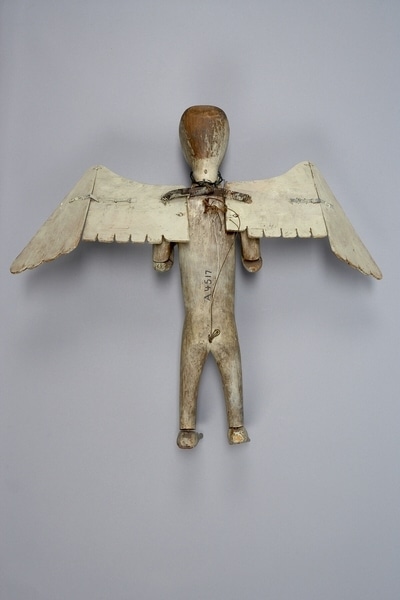Puppet Item Number: A4517 from the MOA: University of British Columbia



Description
Wooden winged puppet; in the form of a human-like figure, painted white, with wings on his back. The spread wings are decorated with stylized U-forms, split U’s, S shapes and ovoids. The arms are bent at the elbows with the forearms extended and palms facing up. The face is white with red, black and brown detailing. Silver foil under the eyes. The head, wings, shoulders, elbows and feet are all moveable.The colours are white, red, black, and green.
History Of Use
These articulated characters are known as dług̱we’ treasures (as are the theatrical dances in which they appear). The Kwakwaka’wakw have history of puppetry related to their ceremonial feasts. The winter potlatches are known for their spectacular performances, suffused with cultural teachings and supernatural content, such as the coming of Winalagalis, the supernatural warrior. Dances and songs associated with Winalagalis include the tuxw’id, which is performed by women, who have the power and rights to make the dług̱we’ treasures (puppets) come to life. For instance, a tuxw’id dancer could make luminous winged-figures appear to ‘fly’ through the air, on invisible cords, in the flickering firelight. Used in the Nunlham dance, they are carried in the hands and the parts move as the person dances.
Iconographic Meaning
Represents dlugiwe' (treasure), of the Nunlham dance.
Narrative
Used in a dance ceremony around 1931 by Emily Baker (according to Dick Hawkins, 1966). One of twelve belongings loaned back for display at the Dawson family potlatch in Alert Bay, Aug 2019.
Item History
- Made in British Columbia, Canada before 1953
- Collected in Kingcome Inlet, British Columbia, Canada and Ukwanalis, British Columbia, Canada
- Owned by William Dawson before April 28, 1953
- Received from William Dawson (Seller) and H. R. MacMillan (Funding source) on April 28, 1953
What
Who
- Culture
- Kwakwaka'wakw
- Previous Owner
- William Dawson
- Received from
- William Dawson (Seller) and H. R. MacMillan (Funding source)
Where
- Holding Institution
- MOA: University of British Columbia
- Made in
- British Columbia, Canada
- Collected in
- Kingcome Inlet, British Columbia, Canada and Ukwanalis, British Columbia, Canada
When
- Creation Date
- before 1953
- Ownership Date
- before April 28, 1953
- Acquisition Date
- on April 28, 1953
Other
- Condition
- fair
- Accession Number
- 1891/0005